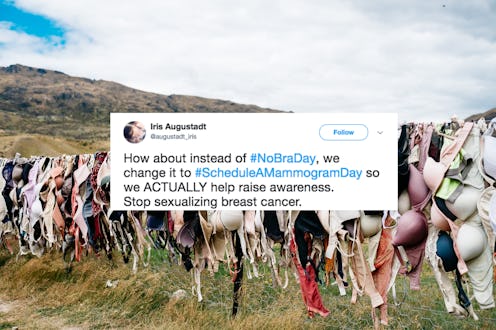Life
Here's Why Women Are Calling Out "No Bra Day" On Twitter
Not that many of us need an excuse to not wear a bra, but Friday, October 13, is “No Bra Day.” Taking place in the middle of Breast Cancer Awareness Month, “No Bra Day” is a social media campaign which encourages women to go braless—sharing photos across their social platforms, of course—in the spirit of breast cancer awareness. If you are unfamiliar with the “holiday” or a little skeptical of its intentions, you are not alone on either front.
Many women have chosen to participate in “No Bra Day” in years past, sharing selfies and stories on Instagram and Twitter using the hashtag #NoBraDay. A lot of the stories are empowering and encouraging, with many women sharing their own experience with cancer or talking about loved ones who have also been diagnosed. “I have Stage IV breast cancer, and I don't want any woman to be afraid of advocating for their health,” a woman named Amanda told Bustle for last year’s No Bra Day.
However, the origins of “No Bra Day” are little unclear. The Sun cites its initial celebration happening in 2011 as does the “No Bra Day” page on the UK site Awareness Days. It seems to have gained attention in 2015, specifically due to criticism from people saying the day does more to further sexualize women’s bodies rather than increase awareness of women’s health.
There is no question whether breast cancer is serious or if its cure deserves cultural and financial support. According to the American Cancer Society, an estimated 252,710 new cases of invasive breast cancer will be diagnosed in 2017. For 40,610 women this year alone, breast cancer will be fatal. Saving lives by raising awareness for how to detect breast cancer or raising money to help find a cure would certainly be worthy of their own holiday. However, a day to post braless selfies has many dubious of “No Bra Day” and its conceit.
“It's offensive,” said Jean Sachs, CEO of Living Beyond Breast Cancer, in an interview with Mashable. “I mean, breast cancer is a life-threatening illness. It has nothing to do with wearing a bra or not wearing a bra.” In fact, there is a much-perpetuated myth that underwire bras cause cancer. However, as Scientific American reports, “bra-caused breast cancer theory is not supported by sufficient evidence.”
In addition to potentially spreading false information, many have criticized the inherent sexualization of “No Bra Day.” Writer Christina Cauterucci summed it up best in her 2015 piece for Slate: “Encouraging women to show off their braless chests in the name of awareness won’t save anyone, but its message to breast cancer patients and survivors is clear: Your disease is about your secondary sex characteristics, not about you.”
“No Bra Day” is far from the first breast cancer awareness campaign heavily shrouded in hypersexualization. Perhaps you are familiar with Save the Ta-tas, a non-profit raising money by selling branded merch. The was also the “bra color as your Facebook status” game of 2010, where women posted a cryptic status that listed a color and no context. Remember the “I Like It On…” Facebook statuses? In that breast cancer awareness campaign, women wrote where they like to keep their purse with the intention of it sounded vaguely sexual (e.g. I like it on my bedroom floor). What do purses have to do with breast cancer, you ask? Literally nothing.
It makes sense that we would talk about boobs in a conversation on breast cancer. It would be uninformed and inaccurate not to. However, it becomes a problem when the conversation treats breasts like decorative objects and not, you know, literally part of a human person. It becomes a problem when the conversation is more focused on saving “boobies” than saving women.
“No Bra Day” and similar social campaigns are certainly ways to start a conversation, but they have to go somewhere from there. You can find and support brands donating their proceeds to breast cancer research. You could share this photo of lemons that shows what breast cancer can look and feel like. You could also schedule a mammogram. There are plenty of ways to contribute to the conversation on breast cancer awareness in a way that is productive and doesn’t reduce people to simply their parts.
